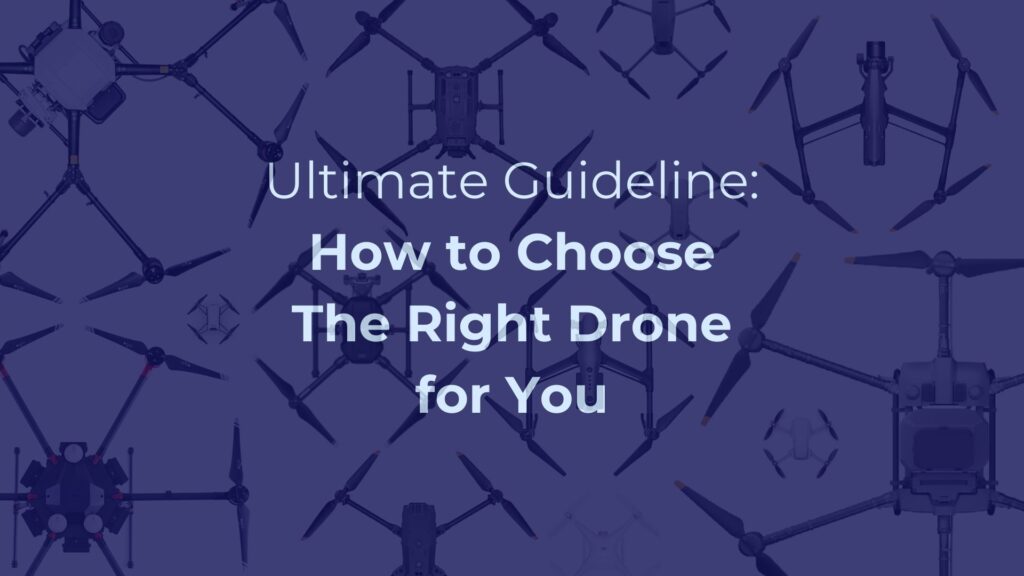الدليل الشامل: كيف تختار الدرون المناسب لك

Intro Over the years, the phrase “drones” has evolved from just a fancy term to a widespread tool seen across the globe. Originally conceived for combat scenarios, these aerial devices now serve countless peaceful purposes. They’ve become increasingly affordable, thus making them accessible for many. Whether it’s for capturing breathtaking aerial photos or aiding farmers in monitoring vast fields, drones have become invaluable in numerous industries. As businesses tap into the potentials of these machines, they’re finding ways to cut costs, enhance efficiency, and even carve out new revenue streams. For those intrigued by the drone universe, this guide is your key. There’s a challenge, though. With so many drones available, how do you pick the right one? The market is full of choices. For a business wanting to make the most of drones, the sheer number of options can be overwhelming. And if drones are new for you or your team, making a wise choice can feel even harder. But choosing a drone isn’t something to rush. It’s a long-term decision. Going for a low-cost drone might seem tempting, but it could lack the features you need. On the other hand, a high-end drone might have great features but could be too costly for your budget. Every business wants value for their money, so finding the right balance is crucial. The key is to start with knowledge. By understanding the basics of drones – what they can do, the types of data they can collect, how to maintain them, and any other related details – you set a good foundation. Think about your needs and the problems a drone can solve for you. With that clarity, you can then focus on finding the drone that matches those needs in the market. Disclaimer : This guide focuses on regular drones, not the ones used by the military. The information provided is up-to-date as of August 2023. Guideline: Understanding Drones and Their Flight Categories Drones, as we know them, have evolved in design and capability. When it comes to selecting one, understanding how they fly can make all the difference. There are several categories based on this criterion, and each comes with its own set of advantages and drawbacks. Here’s a closer look: 1. Fixed-Wing Drones These drones have rigid wings like an airplane. They don’t have the hovering capability of multirotor drones, but they can cover longer distances. Advantages: Endurance: They can stay airborne for longer periods. Speed: They boast a higher cruising speed. Emergency Safety: If there’s a problem, they can glide without power. Disadvantages: Payload Limit: They can’t carry as much weight. Lack of Hover: They can’t stay in one place in the air. Space Requirement: They need a runway or open space to take off and land. Notes: The market for these drones isn’t as expansive. The design and engineering process is more demanding. Most fixed-wing drones are made for hobbyists or professionals, leaving a gap in the mid-tier market. Some well-known manufacturers include Delair and Sensefly. Many manufacturers, however, are transitioning to hybrid designs 2. Multirotor Drones These are perhaps what most people think of when they hear the word “drone”. They have multiple rotors, which give them the ability to hover in place. Advantages: Payload Flexibility: They can carry a reasonable amount of weight. Stationary Flight: Unlike fixed-wing drones, they can hover in a single spot. Space Flexibility: They can take off and land vertically, without needing a runway. Disadvantages: Flight Time: Their flight duration is typically shorter. Speed Constraints: They usually have a slower cruising speed. Emergency Safety: If there’s a malfunction, they can’t glide. Extra systems or parachutes may be needed for safety. Notes: Many major drone companies focus on these designs. Over 90% of the drones worldwide are multirotor drones. Popular brands include DJI, Autel, Parrot, and Skydio. 3. Hybrid Fixed-Wing VTOL (Vertical Take-Off and Landing) These drones try to combine the best of both worlds. They have fixed wings for long-distance flight and rotors for hovering. Advantages and Drawbacks: These drones aim to merge the benefits of both fixed-wing and multirotor drones. However, they may compromise slightly on performance. Notes: Typically aimed at professional usage. They’re gaining rapid popularity in the drone market. Their design and engineering are more advanced than the other types. Renowned brands in this category are JOUAV, Quantum Systems, and Wingtra. By understanding these categories, potential users can determine which type is best suited for their needs. Whether it’s hovering over a specific spot or covering vast distances, there’s a drone out there tailored for every purpose. Type of Payload that Drones Can Carry Based on Type of Activities Drones have evolved from basic flying machines to advanced devices capable of numerous tasks. The variety of payloads they can carry is a testament to this adaptability. Different payloads serve various purposes, ranging from collecting data to performing tangible actions or even transporting goods. Here’s a breakdown: a) Sensing & Remote Sensing (Camera/Sensor): i) RGB (Visual) Captures data in red, green, and blue wavelengths to produce images similar to standard cameras. Use Cases: Aerial photography, event filming, property monitoring. ii) Infra-red Detects data in the infrared spectrum to produce images indicating temperature differences. Use Cases: Search and rescue operations, monitoring crop health, detecting heat loss in buildings. iii) Multispectral Captures light in specific bands of the visible and near-infrared spectrums to produce detailed images. Use Cases: Monitoring crop health, forest health analyses, shoreline changes. iv) LiDAR Uses laser beams to measure distances, producing accurate 3D maps and models. Use Cases: Topographical mapping, elevation model creation, forest canopy research. v) Gas Sensing Detects specific gases in the atmosphere to determine concentrations. Use Cases: Gas leak detection, air quality monitoring, volcanic activity assessment. vi) Magnetic Measures magnetic fields to gather data on magnetic properties. Use Cases: Finding mineral deposits, locating buried structures, underwater investigations. vii) Hyperspectral Gathers information across many narrow bands of the electromagnetic spectrum. Use Cases: Mineral detection
